We all love to see images of luxury homes, don’t we? But what about the other 98% of the human population? What kind of world do they live in? There has to be better minimum acceptable livable habitation requirements for the modern adult, to help them succeed in life. This can be accomplished with the right home programming, ensuring that the inhabitant’s needs are met in an efficient function environment that also raises their ‘positive spirit.’
There are so many different configurations for bedrooms and their associated closets, often the context in which they lie dictates its ultimate layout and size, but what if one looks at each element alone to establish what the smallest bedroom dimensions should be, that is, comfortable in size for a typical adult, to help establish a minimum guideline Architects, Developers and Home Owners should achieve as a minimum when programming a dwelling design.
This type of analysis is fundamental to dwelling design especially related to basic urban dwellings in townhouses, renovations of suburban homes, apartments, condos, co-ops or even designing layouts for housing projects if one cares enough about those who may have to occupy the space provided. This analysis is what Architect Nick Buccalo of SimpleTwig Architecture sets out to do with regards to two basic components of the dwelling, a bedroom and its closet. Future articles will address other programming requirements of dwelling, programming refers here to the basic room names one knows and how those rooms relate to one another.
For this study, we assume the requirements for one adult, which, as adults we all know or hope, the rooms are flexible enough to accommodate two people.
Functionality in dwelling design allows an individual(s) to function on a daily basis, and do so by ensuring there is a positive context in which they live. Positivity in design reinforces a sense of wellbeing and health. Like owning a car, or personal phone, it feels like a reward because ‘you are a special person and deserve it.’ In that this article focuses on minimal standards and sizes, it keeps these very important factors in mind as it should be understood that ‘what is the point of providing a room if it doesn’t function, and, creates a depressing environment for the inhabitant.’ If, through deliberate or ignorant effort one does create inadequate spaces for people, then they expose themselves as being incompetent, and, willfully or through negligence hurt other human beings.
So one can say functionality has to do with both one’s ability for physical function within a room, in that the room has a purpose, and two, helps lift the spirit of the person to avoid a depressing circumstance.
Lets break down the functional requirements of a typical bedroom in terms of the physical components, and then explain how those components should perform for a typical adult individual.
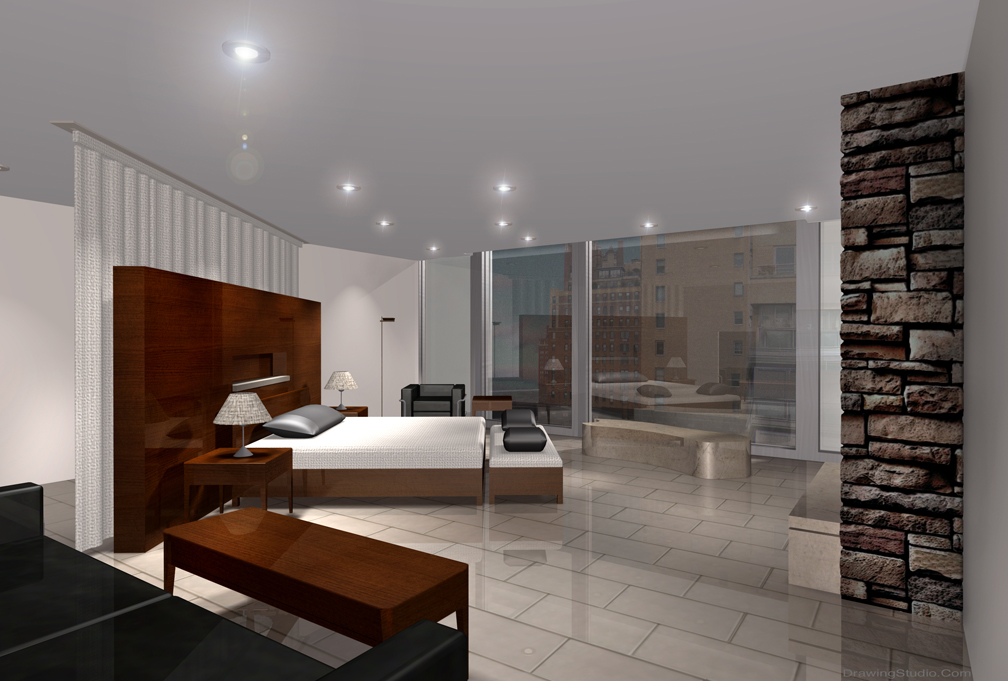
BEDROOM:
Bed and Side Tables: First, there is a need for a queen-sized bed, oversized to the length of 6′-6″ (typically queens are 6’x6′). This will accommodate the most typically sized adults comfortably. Flanking this bed are two nightstands with lamps, at least one drawer in each and preferably two, to accommodate alarm clocks, reading glasses, a book, etc.
Room Width: The bed and side tables establish the width of the room, which is 10 minimum. This allows for 2 feet on each side of the bed for access, and for the night tables, ensuring that no one is bumping their toes or having to squeeze through in order to use the bed.
Dresser: The dresser is 6 feet in width, 2 feet maximum in depth, to align with the bed and to provide ample storage as the occupant see fit. This supplements the walk-in closet noted below. As having a useable top, this is a dresser that is at the same general elevation (height) as the bed to help keep the bedroom feeling open and spacious.
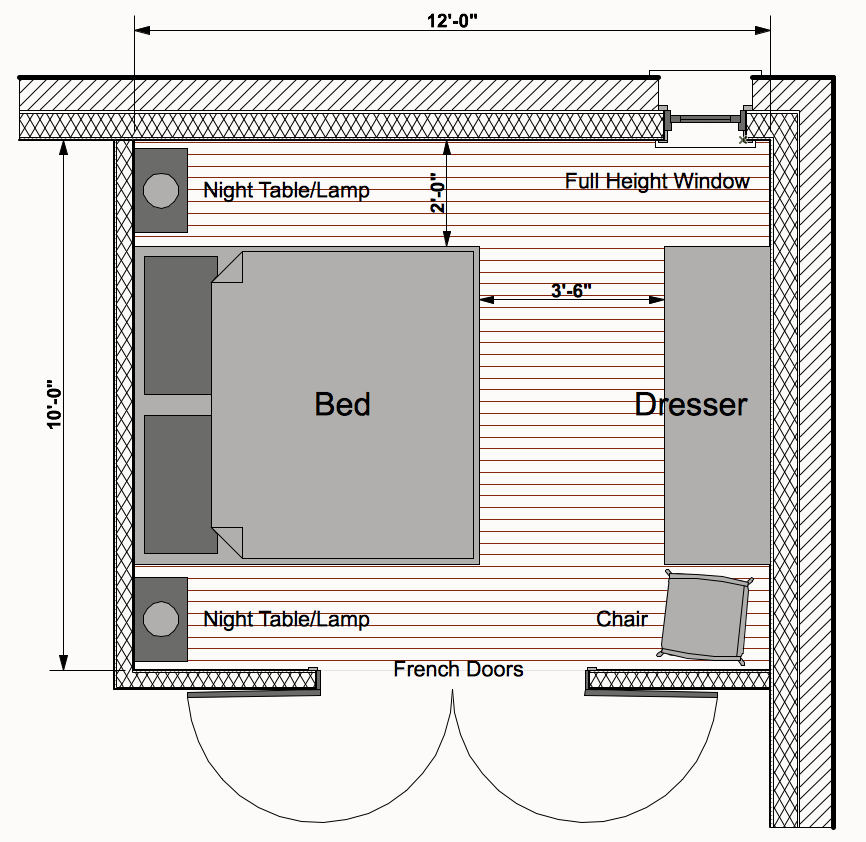
Room Length: With both the bed and dresser in place, we can establish the minimum length of the bedroom, allowing for 3′-6″ between the foot of the bed and the dresser, allowing for easy circulation and access to the dresser, without making the bedroom feel cramped (again protecting those toes). This means the interior length of the room must be 12 feet in length.
The Floor: hardwood, comfortable to bare feet because of the material, wood, is fibrous and thus does not convey heat or cold easily, keeping it a comfortable temperature to walk on, and, making it easy to keep clean. Rugs should not be shag in order to ensure they remain dust free, keeping the air within the bedroom fresh and easy to consume.
Light and Ventilation: The room has one window, as it is understood that the function of the room is to get sleep and thus needs to remain dark and at a comfortable temperature, but the window is special compared to conventional choices in that it is full height, from floor to ceiling, to maximize the amount of light into the bedroom when used for this function. It is also situated next to an adjacent wall, to further maximize light. It is operable, but with an awning type situated close to the ceiling, to allow for hot air to escape into the night and draw cool air into the bedroom during the summer, while ensuring that rain water does not enter the interior if left open.
Because the window if full height, it can afford to be narrower than a typical window, shown here to be 1′-6″. This study has nothing to do with potential views a site may offer, but instead focuses on the requirements of having a functional sleeping quarters. By making it narrow it is easier to provide shades, and, lessens heat loss in the winter or heat gain in the summer. Making the main pane a fixed window reinforces the insulation qualities as there are fewer joints or potential leaks while at the same time providing a smaller awning window which has a robust frame to glass ratio making it easier to close and structurally stronger than larger operable windows.
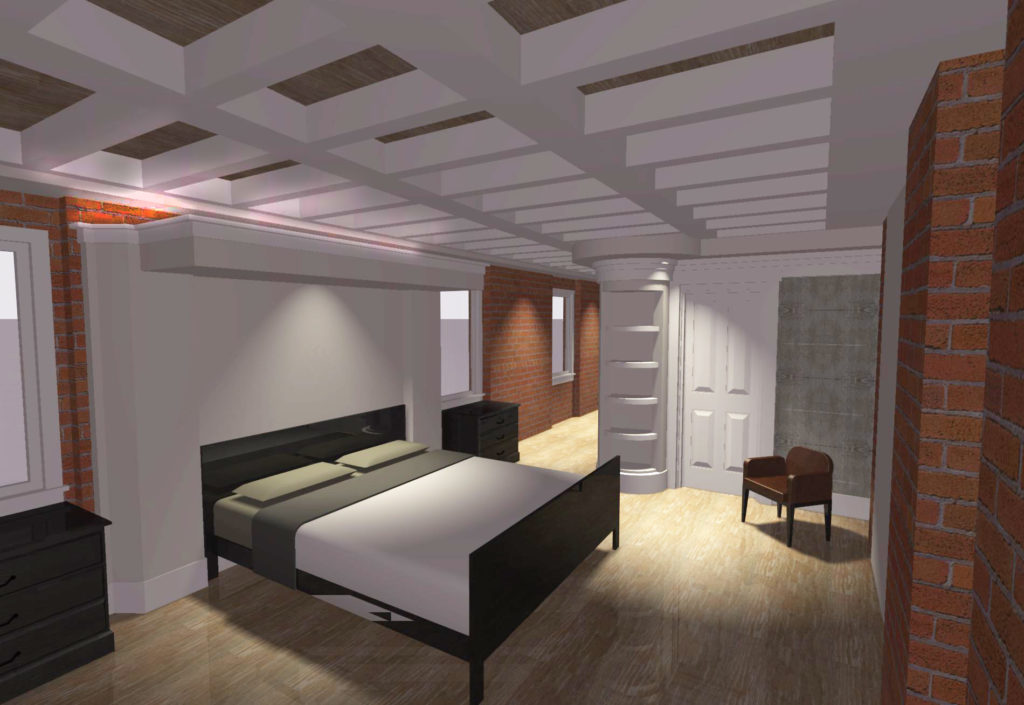
Having one controllable opening also offers easier privacy and better sound control from noise pollution. Considering that most urban dwellings have their bedrooms at the rear of the property, where one does not have views and privacy/sound control are critical, one window is easier to build and provides the functional necessities for a perfect bedroom habitation.
Morning sun and window location can be a factor, that while having direct sunlight hit the pillows can be okay at 10 AM, it is not ideal if the sun hits the pillow at 5:30 AM. While sun angles vary during each season, this is a factor and can influence the depth of the opening, the placement of the window, whether their is a sun screen or other measure to help ensure ideal conditions on the interior.
Insulation and Sound: You may note that the walls shown here are 5 1/2″ thick with an R-18 insulation. While insulation can be handled in a variety of ways, unless one lives in a temperate climate R-18 is required for two reasons: 1) to reduce heat and cold gain thus keeping the interior always at a comfortable temperature, and 2) providing adequate sound insulation and dampening to help keep the bedroom quiet and free of noise pollution that can disrupt a sound nights’ sleep.
Door Access: While on most dwellings where the Master Bedroom exits onto a hall, thus preventing french style doors, here we’re looking at the best solution for an adult sized bedroom without the constraints of context, and in this circumstance having ample width serves four purposes, one it is easier to gain access or egress, two, offers that adult-sized positive feeling, three, encourages air flow, and four, helps open up the entire apartment making it feel spacious while still offering a way to close off the bedroom for privacy if needed.
Chair: In all bedrooms their should be a convenience chair, which can be a simple chair for the dweller to help them get dressed. If one has an infant, then the size of the chair and thus the size of the bedroom could be changed to accommodate a comfort chair, but typically the baby period for small apartments (meaning perhaps only one baby) means that a comfort chair could be located in the living room. Functionally, on behalf of a single adult (or couple), one simple chair will suffice. This is located next to the dresser.
Ceiling Height: While code dictates a minimum of 8 foot ceilings, this is an arbitrary condition that assumes this is what people need. The truth, for bedrooms, is quite different. Certainly 8 feet is reasonable, but considering doors are a standard 6′-8″ the requirement isn’t to prevent people from bumping their head. If anything, 8 feet will probably prevent most finger prints on the ceiling surface, but not all. I guess you could say it is high enough to allow most people to stretch their arms.
The reality is, in hot climates ceilings should be higher than 8 feet and allow for trapped hot air to escape (which they often do not), and in colder climates the ceilings of bedrooms should be lowered to 7 feet to help keep hot air closer to the bed surface. In this way there’s a logical reason for bedroom ceiling heights that actually serves the needs of people. Further, in colder climates this would also help reduce fuel consumption and heating bills. The only other reason, besides being dictated by code to provide 8 foot ceilings, is the use of standard sized building supplies, specifically sheetrock which comes in 4′ heights, thus stacking 2 sheets prevents the need to custom cut it.
Ceiling Insulation: For bedrooms adjacent to a roof, the minimum R factor (resistance to heat loss/gain in terms of time) should be R-36 and for the rest of the home R-30. This is to prevent temperature fluctuations which can disturb sleep, keeping the room temperature constant throughout the night, especially when the thermostat is turned down. While this may seem an extreme measure, for your basic human being, it’s about setting a standard that ensures basic comfort.
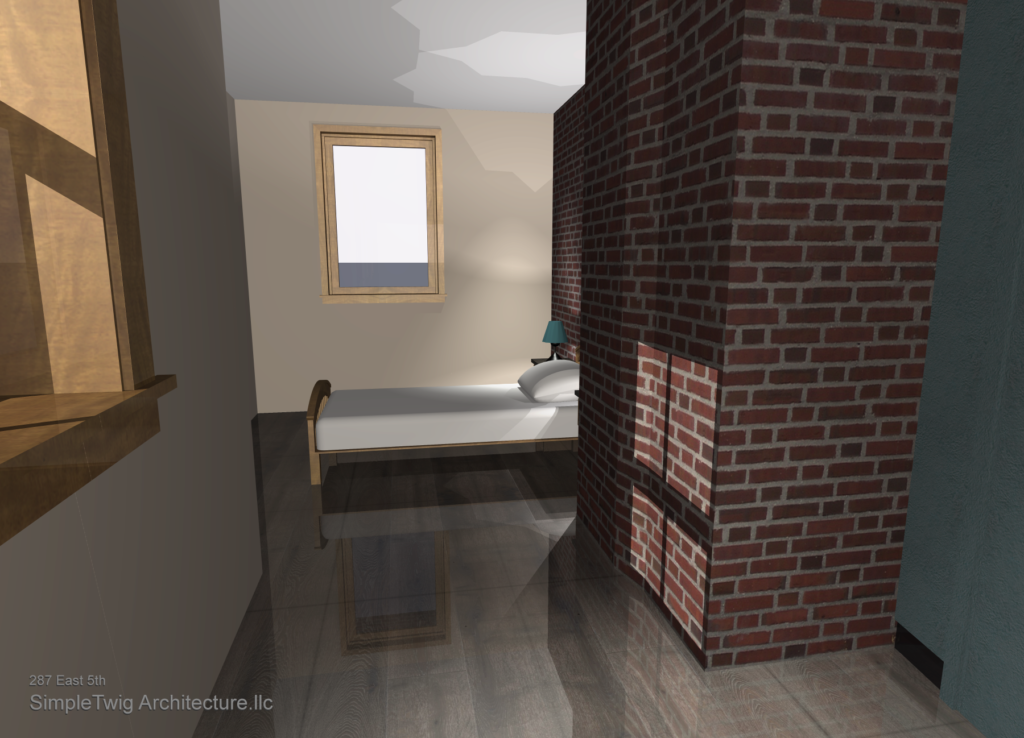
Ceiling Acoustical Insulation: Like the partition walls, a minimum of 3 inches of acoustical insulation should be installed in the ceiling that is adjacent to another floor, to dampen foot steps or other noises. In today’s world this would ideally be accomplished with spray foam type insulation in order to fill in cracks which easily defeat sound mitigation.
Lighting: Besides the table and dresser light fixtures, there should be two other types of recessed down lights: one as an accent light focused above the headboard of the bed, for artwork or some other feature (without shining into the eyes of those in bed), and the other general down lights to provide illumination at the dresser, flanking both ends of the dresser. Each built-in fixture should be on a dimmer switch. This is what adults require as a minimum. Ideally they would use warm toned LED bulbs to prevent the need to replace them constantly, to prevent the buildup of extra heat in the room and avoid any danger with ceiling insulation, and to be energy efficient.
Other, Cloths Closet and Bathroom Considerations: While I review the requirements of a closet below, it is clearly not shown connected to this bedroom, nor is a bathroom. Assuming it is a one bedroom apartment, one would want the single bathroom located in such a way to accommodate guests without having them walk through the bedroom. With regards to the closet, in the above plan with french doors centered on the room an extra door to a walk-in closet would be difficult to accommodate. Still, ideally the walk-in is connected in some way to the bathroom, thus it could be located elsewhere, or part of the bedroom where a person would want to sit in order to change. We offer plans for both solutions, separate and combined, noted below.
BEDROOM CLOSET:
There is only one type of closet that is appropriate for an adult, and this is the walk-in closet. Large enough to accommodate two adults and ample cloths storage space, it is also designed as with being as small as possible, to save on construction costs without sacrificing functionality. Again, a walk-in closet is as relevant to the entire program of a home as is the front door, so it should not just be skipped or ‘closet space’ be added as a footnote to the overall design of a dwelling.
First is the door opening, a minimum of 2 feet wide (not HC sized, please note), and 2 feet for each hanging area, thus creating a width of 6 feet. This allows an adult to enter, turn, pull out cloths and exit the closet. The door is shifted off center to allow for more room to open the door, noting that the door swing is to the interior preventing it from becoming a space waste to the area outside of the closet.
Hanging cloths are split into two areas, one for full length cloths, light coats, pants and dresses, while the other half has two rods, one above the other, for shirts, thus offering 11 feet in cloths rod length. That is, considering a conventional closet, it would mean the closet is 11 feet in length which would be considered very reasonable.
Above the cloths rods is a shelf, below are additional shelves as required, all to make the walk-in a functional machine whose purpose is to help serve the dweller with a fully functional and easy to use room. At the base is a baseboard aligned with the baseboard of the shelving area noted below, and for the same reasons.
Shelving: there are two flanking floor to ceiling shelf areas. The shelf area behind the door is for sweaters, perhaps towels, etc. (seasonal or periodic use) while the ‘easy to access shelf area’ is for shoes and socks (the things one needs every day). The bottom shelf sits above the floor at a minimum of 5 1/2 inches and has a baseboard that wraps around the partition wall. This prevents dust from accumulating on clothing items while ensuring the walk-in is easy to vacuum.
The flooring is wood, again because its temperature comfortable to bare feet.
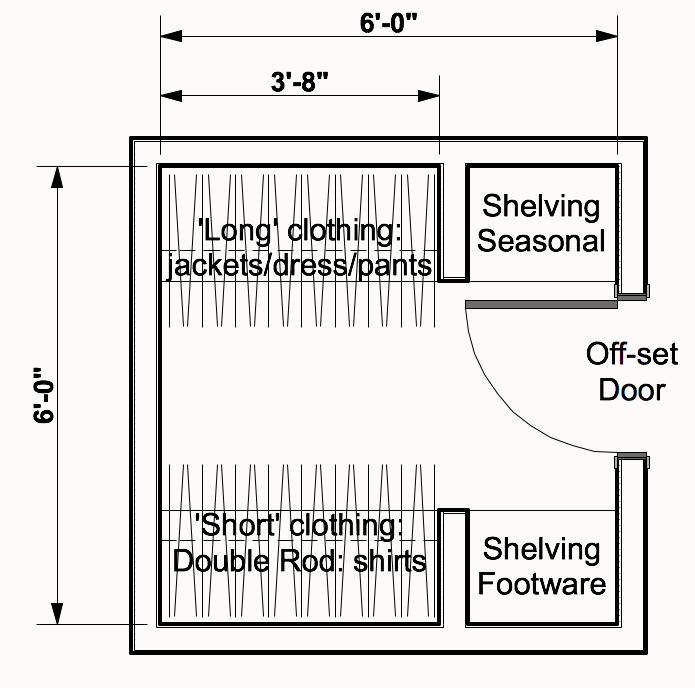
Why not have a non-walk-in closet that is 11 or 12 feet in length, just one long closet served by sliding doors? Note on the walk-in there is only one door. This provides the dweller with more usable interior wall space. On a 12′ long closet one would need several doors (costing more to purchase and install) to gain access to all parts of the closet (even though those back corners are typically still hard to reach making some cloths lost for years, haha) and one looses valuable wall space resulting in the need to provide more area to make the bedroom seem spacious. Still, one could make the argument that the walk-in closet looses 2’x6′ in required circulation space and thus is added square footage to a dwelling, but, for the given reason, the walk-in is just plain more functional for the adult, and, helps create a clean living environment for the dweller to inhabit. Further, all those extra doors not only adds cost and time to the construction process, but has an added maintenance factor as the doors get used. No doubt developers would rather have a single hinged door rather than have bi-fold or sliding doors which inevitably break down and need repair or replacing.
Lets also consider functionality of sliding doors, that while one section can be open, other sections are very closed, thus preventing one to see all their clothing choices. There are other factors, like the marring of the floor, the unsightly look of sliding doors which have cracks below, above and between door panels, making the closet seem creepy, or the greasy hardware which isn’t ideal to have above one’s cloths.
Closet Lighting: There should be two recessed down-lights, one at each end, so that the human body does not cast a shadow onto anything they are looking at but instead illuminates the clothing and reflects light off the wall and door surfaces further helping in illuminating clothing. The down-lights should have a wide spread, be LED warm tone bulbs and NOT be on a dimmer. Lighting control switch must be in the door jamb, to meet code requirements (to prevent lights from burning inside a closed closet unbeknownst to the home owner) and to reinforce the habit of closing the closet door like one would close the refrigerator door, thus enhancing the living environment.
COMBINED BEDROOM AND CLOSET:
As shown here, one can combine the ideal, minimin-sized adult bedroom with the minimum-sized adult closet, sacrificing the french doors, but even here it ultimately comes down to the context in which the bedroom has to reside and whether a closet of this configuration can be accommodated within the footprint, while not creating some unfortunate circumstance in another part of the plan.
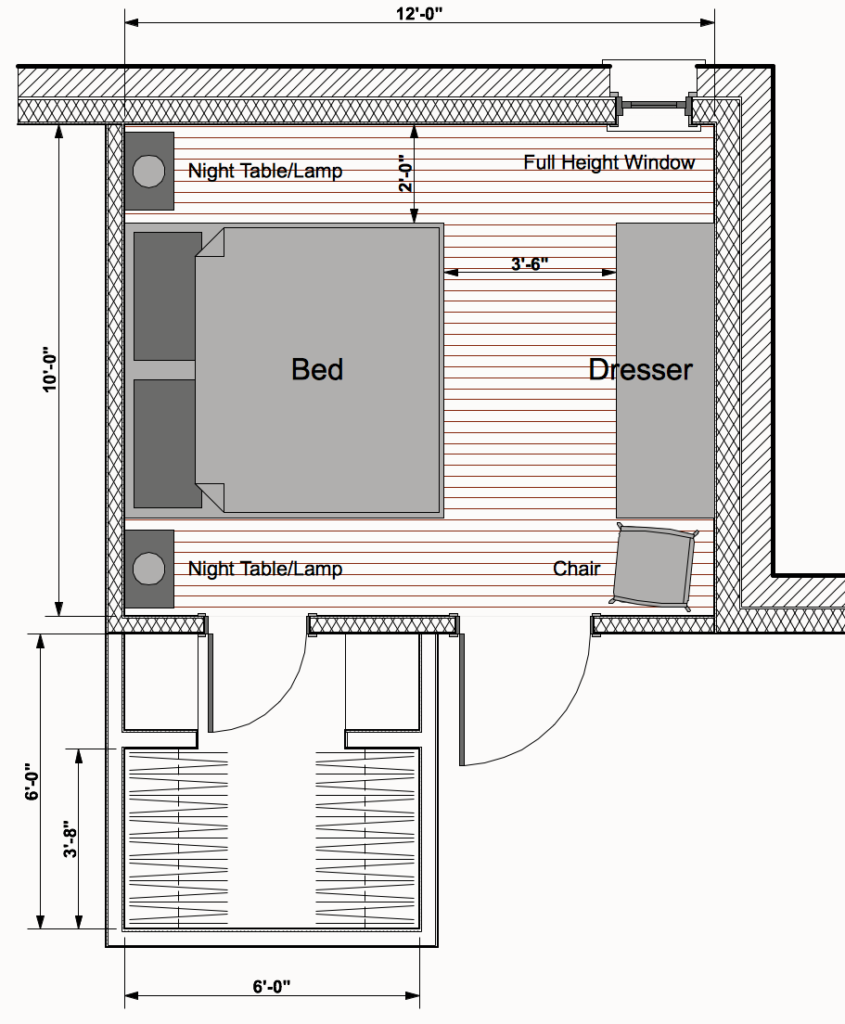
In the above plan example, one would expect to adjust the bed and dresser location towards the exterior wall, to allow for additional circulation space to the closet door (adjustment not shown).
STORAGE:
In order to have and maintain a successful bedroom and closet, one must provide general storage space associated with the unit, and at a minimum it is also 6’x6′ is size thus offering two side walls to store things. This allows humans to store boxes and other miscellaneous items that are not used every day. Without this storage the dwelling program does not meet the minimum requirements of all adults, and the bedroom and walk-in closet will fail (in functional terms) as will other parts of the dwelling. Storage should not be considered a supplement or extra feature of any dwelling unit, but be as fundamental to the program as is the front door.
OTHER CONSIDERATIONS:
Handicap: Handicap is not considered in this study as it is not a requirement for a typical adult, as addressed here. While that might be the case, all bedrooms, closets and other functional components should accommodate HC requirements whenever possible, to provide extra space for non-wheelchair bound individuals and accommodate changing circumstances one might find themselves in. Still, in urban locations where HC requirements are only required for a small percentage of dwellings, or where limited space is available due to budget or existing renovation conditions, this study does remain valid.
Code: This study does not account for code requirements, but it is believed they are met, assuming the light/ventilation requirement is accommodated, which it is this Architect’s opinion that these requirements are too strict and do not account for actual human needs but are just generalized and unfounded guesses at what a human should need, understanding that any human dweller can completely block their windows from all daylight and ventilation and that doing so is not illegal, making these code requirements a mute point and restriction to Architects and developers. Still, not having any light or ventilation is wrong. Cross ventilation can be accommodated extremely well with the smallest opening if that opening is in the right place. In the wrong place the largest opening will provide little ventilation, or specifically needed cross ventilation to help clean the air quality of a room. Further, positioning a window next to an adjacent perpendicular or splayed wall can reflect a lot of light into a room, making it feel brighter than a room with more windows that are located centered on multiple walls. This, for me, is Architecture 101 and was taught to me by the Rococo Architects whose creative use of openings ensured that their interiors were highly illuminated while all the openings were hidden to the user’s eye. That, right there, makes the code feel like it was written by amateurs and imposed upon the ignorant. Light can be measured and it is this that should be in the code, not the size of a window which is 4 stories below the roof line and situated in a ‘light well’.
CONCLUSION:
So, did you think so much was involved in fully considering the requirements and functionality of two simple dwelling spaces? What are your thoughts? Would you feel comfortable in a bedroom of this size, if you knew it was a minimum sized bedroom and closet, or do you think an 8’x8′ bedroom with a 2’x4′ closet is enough?
Certainly rooms can get larger, but often designers, developers and dwellers accept much smaller areas to live in. Code requires that all bedrooms be a minimum of 8’x8′ which might be okay for a young child, but hardly creates a nice living circumstance for an adult-sized human being, yet the code focuses on a strict light/air requirements based on an unscientific ideology, often providing neither light or air or worse creating a circumstance where getting sleep, the primary function of a bedroom, which by the way occupies 1/3 of our entire lives (some 30 years!), is disrupted and impossible to achieve.
So I Nick Buccalo, as an Architect, factors all these things into every design, for bedrooms, closets and all other programmatic components of a dwelling(s). It is the push and pull of many factors that ultimately generates the final design scheme, all to the delight of clients, or to their utter ignorance.
Bedroom image curtesy of ‘It All Started With Paint.’ Thank you!
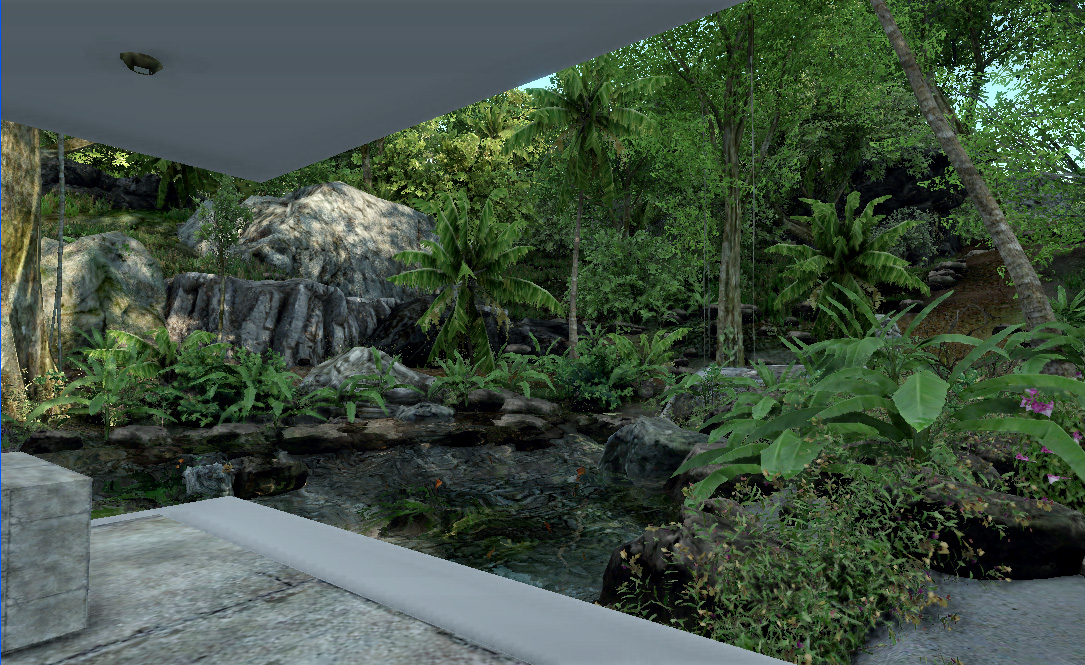
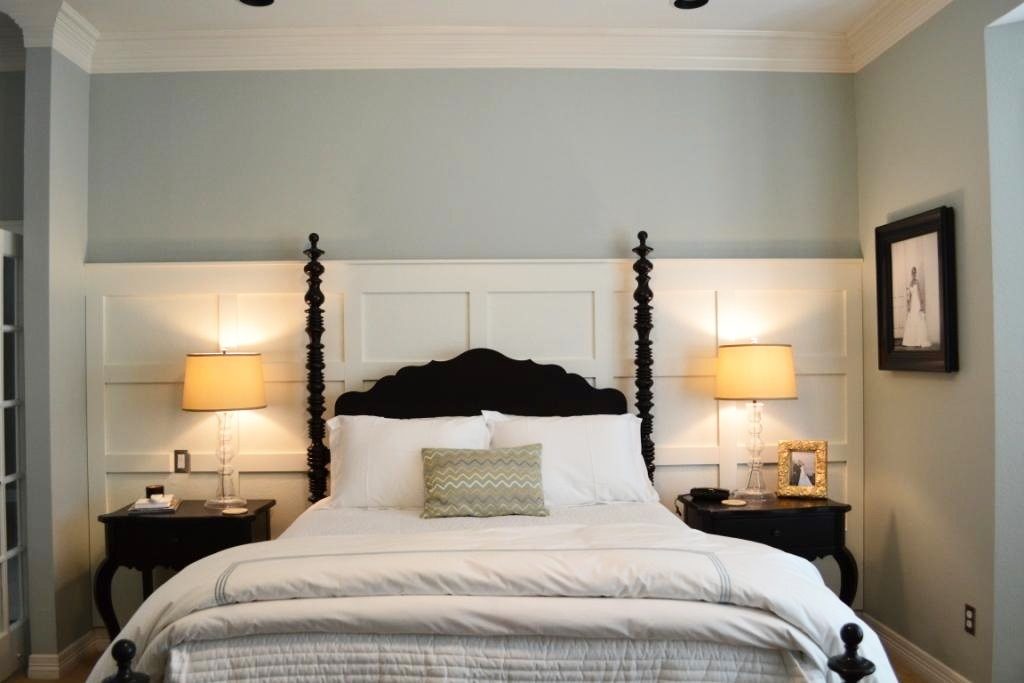
Thank you for your helpful tips and drawings. I am creating a new addition to include M/B and closet and bath. I appreciate your time in sharing this. I’m excited to start designing it.